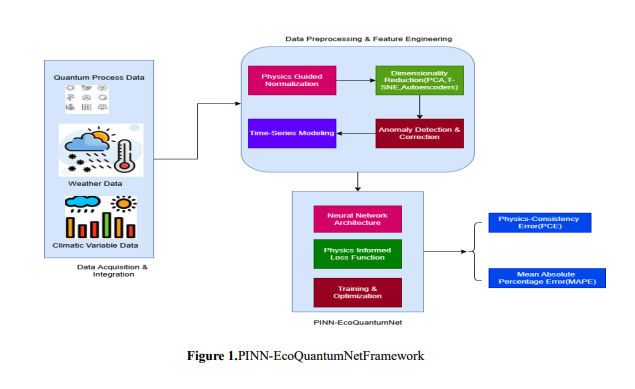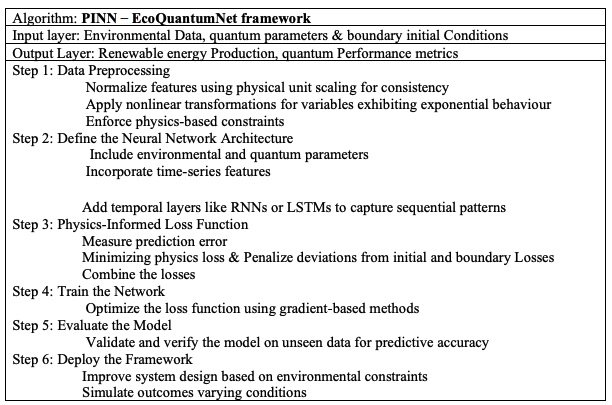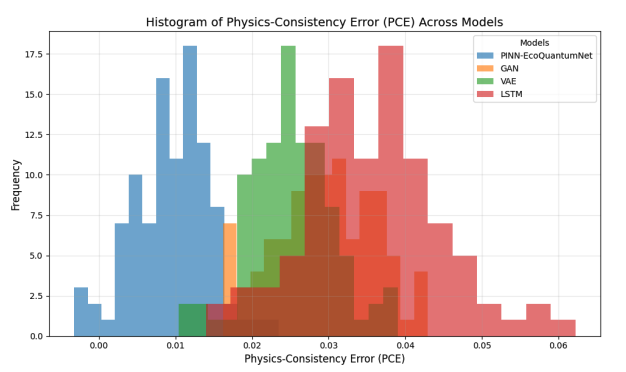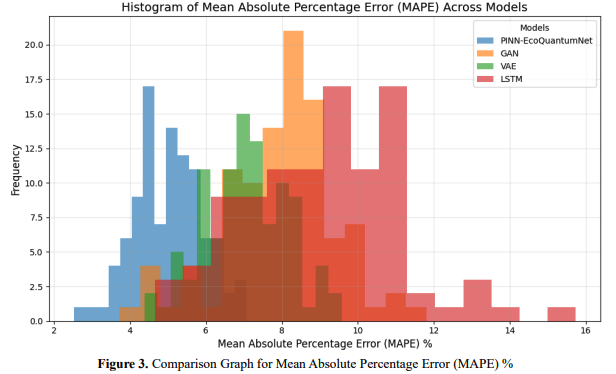ARTIFICIAL NEURAL NETWORKS FOR MODELLING AND SIMULATING QUANTUM PHENOMENA IN ECO-FRIENDLY GREEN ENVIRONMENTAL TECHNOLOGIES
Authors :
Norul Fadzil and Adnan Subir
Address :
Electrical and Computer Engineering Dept., College of Engineering, University of Duhok, Iraq
Division of Research and Development, Lovely Professional University, Phagwara, India
Abstract :
Slow global warming, protecting our planet's natural resources, and environmentally conscious green technology are increasingly essential in the fight for sustainable development. This project aims to use ANNs, especially PINNs, to describe and simulate quantum events that affect the efficiency of renewable energy sources like wind and solar power. PINNs excel at this because they may include physical rules that regulate environmental processes; hence, they are perfect for datasets that include meteorological variables such as temperature, wind speed, sun radiation, and other similar variables. Forecasting how renewable energy systems would act in different scenarios, the technique entails training PINN-EcoQuantumNet on a sizeable environmental dataset that includes time series data on sun intensity, wind patterns, and temperature variations. Important results demonstrate that by including physical restrictions, Physics-Informed Neural Networks (PINNs) increase the accuracy of predictions and programmes' capacity to represent dynamic processes controlled by quantum mechanics. Possible innovations in environmentally conscious technologies can also be better understood using data collected from client records. Since PINNs that accurately portray complicated quantum and ecological interactions, scientists have concluded that they constitute a useful tool for promoting creativity in the preservation of the environment.
Keywords :
Physics-Informed Neural Networks, quantum phenomena, meteorological data, efficiency of green technologies, renewable energy systems
1.Introduction
Warming of the planet and depletion of resources pose a hazard to ecosystems as well as to mankind. There has been a growing interest in green technology as a sustainable solution for environmental problems. For sustainable development to occur, it is necessary to get a knowledge of wind and solar power efficiency and to improve it in order to reduce the use of fossil fuels [1]. The changing nature of winds, temperatures, and solar radiation rendering it challenging to precisely evaluate and enhance the effectiveness of renewable systems. This is due of being aware that these factors are all subject to change. In the current study effort, artificial neural networks (ANNs) and particle ion neural networks (PINNs) are applied to represent fundamental phenomena and the consequences that these incidents have on energy-producing systems.
Environments that are complex and constantly changing are the source of renewable energy [2, 3]. PINNs are provided with a stable platform for recording system dynamics by the application of physical principles in learning, which has the effect of improving both reliability and efficiency [4]. The performance of renewable energy systems may be modeled and predicted using PINNs. In order to get accurate responses with low or noisy input, PINNs, which are a subtype of ANNs, use physical equations during the training process. When doing research, it is necessary to collect a comprehensive time series of sun intensity, wind patterns, temperature variations, and other meteorological factors [5]. Key contributions to renewable energy optimization include:
- Physical constraints help PINNs evaluate renewable energy system performance.
- Understanding quantum phenomena illuminates how quantum-level events affect energy conversion, enabling novel optimization strategies [6].
- Green Tech Development Advice to help create green technologies, supporting global sustainability goals [7].
The paper is organized as follows: Section 2 is the Literature Review, which provides an overview of existing methodologies and the challenges in modelling renewable energy systems. Section 3 is described as Methodology with a Detailed description of the data collection, PINN design, and training processes. Section 4 is the Results and Discussion about the Presentation of key findings, with an analysis of the predictive accuracy and implications of the model. Section 5 is the Conclusion and Future Work summary of contributions, limitations, and recommendations for further research in this area.
2. Research Methodology
Oliveira Santos et al.[8]The present study presents a Quantum Neural Network (QNN) model that can estimate the amount of sunlight for as long as three hours in preparation. Compared to more conventional approaches such as Support Vector Regression (SVR), Group Method of Data Handling (GMDH), and Extreme Gradient Boost (XGBoost), the above method improves forecasting precision by applying QNN concepts to spatial and temporal patterns in weather data. Forecast intervals ranging from 5 to 120 minutes were used to examine time-series data on radiation from the sun, weather conditions, wind speed, and saturation. With an RMSE of 77.55 W/m² and an R² of 80.92%, these results suggested that the quantum approach achieved the second-highest performance for 3-hour forecasts. The concept has been successful, although it does have certain drawbacks, such as increased computing costs and difficulties with scaling. This study highlights QNN's promise of extended perspective prediction by surpassing conventional approaches to capture intricate environmental relationships.
Monika Singh et al.[9] Quantum Machine Learning (QML) approaches such as QPCA, QBM, QNN, and QSVM are examined during this study as they apply to environmental predictions. Different times and locations are included in this information set, encompassing climate variables such as temperature, humidity, wind speed, and pressure in the air. Regarding computational economy, accuracy, and scalability, QML modelling exceeds conventional methods for detecting nonlinear relationships in massive data sets. However, there are problems with data quality, rates of errors in quantum circuits, and integration of traditional and quantum technologies. We need to get around technology and organizational limits to widely employ QML in weather forecasting, but it has great promise to increase the precision and efficacy of weather predictions.
Baklaga et al.[10] Quantum-enhanced machine learning techniques assess solar radiation, wind velocity, and pumped-water electricity stored information to forecast and maximize alternative energy sources. The data includes green energy network solar radiation, wind speed, humidity, and utilization patterns. QAI improves energy forecasting precision, energy administration, and lowering waste by outperforming traditional artificial intelligence models regarding computational effectiveness and prediction accuracy. High implementation expenses, limited atomic equipment accessibility, and energy system integration challenges persist. The examination found that QAI can increase environmentally friendly electricity manufacturing and leadership, but additional investigation must be conducted to remove technological barriers and optimize how it is utilized.
Bhatt et al.[11] According to one research, green AI with biodegradable and biocompatible materials may change gadgets and medical care. The material characteristics, impact on the environment, and therapeutic equipment efficiency are studied utilizing energy-efficient and highly effective machine learning techniques. Reviews include findings on healthcare devices, biodegradable plastics, natural substances, and environmental indices of value. AI and intelligent biological materials improve durability and ecological suitability regarding equipment efficiency, carbon footprints, and waste from electronic devices. Network dependence and biocompatible material adaptability, while elevated starting prices persist. Environmental AI might transform environmentally friendly technologies by improving material efficacy and reducing environmental impact. More research is needed.
Hassanien et al.[12] The present study investigates Quantum Machine Learning (QML) technologies such as QPCA, QBM, QNN, and QSVM for weather forecasting. Information gathering includes humidity, wind speed, temperature, and atmospheric pressure data from various places over various periods. QML approaches surpass standard approaches in identifying nonlinear relationships in massive data sets about scalability, accuracy, and computing economy. Nevertheless, quality of data concerns, quantum device error rates, and classical-quantum system cooperation problems exist. QML has significant potential for improving weather forecasting accuracy as well as effectiveness.
Al-Hajj et al.[13] Projections of one day's solar radiation are necessary for tied-grid renewable energy management. Short-term solar radiation is better predicted by many machine-learning ensembles. Optimal ensemble models with individual predictors are challenging due to tuning and other restrictions. Practical machine learning ensemble architectures for predicting solar radiation are rarely compared in research. This study examines stacking-based ensembles of data-driven machine-learning models. Forecasts of individual solar radiation intensity are based on radiation and meteorological data. SVRs, k-nearest neighbours, and feed-forward neural networks were integrated with the output of base learner predictions. For solar radiation, the heterogeneous neural meta-model is the best stacking model.
3. System Methodology
a. EcoQuantumNet framework designed for modelling and simulating quantum phenomena in eco-friendly green environmental technologies

b. Advanced-Data Acquisition and Integration
The EcoQuantumNet architecture ensures the best possible preparation with the least noise and duplication by collecting, cleaning, and integrating various renewable energy and environmental data types. The three primary sources of information required for this task are (1) Weather data (including air temperature, humidity, wind speed, solar radiation, and pressure) (2) Quantum process data (including measurements of quantum efficiency, photovoltaic material properties, and the operation of wind turbines under quantum-driven effects) (3) Climatic variable data (Collectively, geographic information includes topographical features that impact the dispersion of solar radiation and wind) and location-specific metrics like height, latitude, and longitude.
Compatibility across dimensions such as time, space, and format while dealing with several data sources adds another degree of complexity. It is considerably more challenging to synchronize temporal and spatial when environmental data is frequently collected from several locations and at irregular intervals. Dynamic time warping may bring together datasets with different temporal resolutions, and methods like spatiotemporal interpolation can fill in data gaps and make records continuous. In both structured numerical variables (such as wind speed and temperature) and unstructured data (such as satellite photos), the system employs CNNs and other advanced deep-learning models to detect significant geographical patterns. Multimodal data may be integrated in this way.
c. Working On Features and Dimensionality Reduction
System representation of physical and quantum interactions improves with feature engineering. Complex topical procedures alter data. GHI and sun zenith angle measure solar energy. Apply the cube rule of wind energy.

Surface roughness data assesses wind energy, which considers wind direction—resulting in traits that simplify model and nonlinear connections.
- Timing: Fourier Environmental data is transformed daily or yearly. Separating temporal data into sinusoidal components may reveal repeating trends like increased wind speeds in summer or more solar radiation.
Photon absorption coefficients, quantum efficiency, and exciton binding energy are quantum parameters. These parameters are determined using quantum mechanics simulations or experiments. These are crucial to understanding solar and wind energy quantum effects. Shrinkage Reduces data dimension. These technologies protect data and reduce computing.
PCA finds principle components—orthogonal planes with the most significant variance—to minimize dataset dimensionality. PCA may keep wind speed and temperature fluctuation while combining closely linked data. Thus, useless data is removed, and beneficial data is preserved. T-distributed Stochastic Neighbor Embedding (t-SNE) transports high-dimensional data to a lowerdimensional environment while preserving the local structure and Supporting nonlinear data. Environmental or quantum nonlinear data shows patterns and clusters. Autoencoders: Neural networks reconstruct massive data sets. Network training showed nonlinear interactions between compressed latent layer measurements on the dataset. Humidity, temperature, and quantum efficiency interact. For nonlinear data, autoencoders surpass PCA.

d. Physics-Guided Data Normalization and Preprocessing IN PINN Algorithm
Machine learning models need scaling and standardization for numerical stability and data consistency. This way, all aspects are standardized to fit the physical equations of renewable energy systems. So, m/s is the wind speed unit, and W/m² is the unit of solar irradiation. Saturation and exponential variables are fitted with nonlinear scaling. Logarithmic transformations show the nonlinear effect of low solar irradiation, whereas sigmoid scaling shows restricted variables like quantum efficiency inside [0,1]. Improved model convergence and interpretability are outcomes of simplifying data linkages.
During preprocessing, constraints based on physics ensure that datasets are compliant. To exclude unfounded results, we use the Stefan-Boltzmann formula for radiation.

There is no negative global horizontal irradiance (GHI), and the wind can only be directed between zero and three hundred degrees. Characteristics unique to quantum systems, such as photon absorption coefficients and exciton binding energies, are experimentally limited. Datasets are physically cohesive and in line with real-world events when preprocessing restricts them.

e. Anomaly Detection and Correction
Mahalanobis Distance Identifies multivariate outliers by measuring the distance of a data point from the mean, considering feature correlations. Isolation Forests A machine learning-based technique isolates anomalies by partitioning the dataset and identifying instances with sparse distribution.
Domain knowledge is leveraged to adjust anomalies. For example, extreme temperature values outside historical norms are adjusted using seasonal weather patterns or nearby station data. Missing or corrupted GHI values are reconstructed using temporal interpolation or satellite-based measurements.
f. Time-Series Modeling and Data Augmentation
To improve the dataset so that EcoQuantumNet can be trained more reliably. Fundamental for alternative energy and quantum event models. This part examines complex inter-variable interactions, records temporal dependencies, and models various scenarios using advanced time-series modelling, data augmentation, and cross-correlation analysis.
Only by using time-series modelling can the patterns and correlations in environmental and quantum data be captured. Lag features are generated to train the algorithm to recognize sequential patterns using the wind speed and solar irradiation from the past hour as temporal dependencies. Seasonal-trend decomposition (STL) separates time series data into trend, seasonal, and residual components to uncover patterns and trends across more extended time frames. All of the time-related data is now easier to understand. Incorporating data augmentation into the model's simulation of several environmental conditions improves its robustness. Generative Adversarial Networks (GANs) simulate weather conditions, including wind speed, temperature, and solar radiation, to generate fake data. So, even in very unusual cases, the model performs admirably. One can use a controlled perturbation technique to test how well the model handles small changes, such as adjusting the wind speed or temperature. These supplementary datasets improve simulation quality by increasing model generalizability and training data variety.
Using cross-correlation analysis, researchers can determine how changing one parameter affects another variable. Look at how GHI, wind speed, and temperature interact. Based on these results, EcoQuantumNet is the superior predictive modelling framework for using the interdependencies between quantum and environmental factors. This module's time-series analysis, improved datasets, and cross-variable correlations will make the dataset resilient for dynamic simulations. Predictive power and robustness are enhanced when models trained on the dataset are affected by physics.
4. Result Analysis
a. Performance Metrics for Evaluating the EcoQuantumNet Framework
Three essential measurements, namely Physics-Consistency Error (PCE), mean absolute percentage error (MAPE), and Energy Efficiency Prediction Score (EEPS), can be implemented to assess the effectiveness of the EcoQuantumNet building design accurately. The precision, consistency with regulating scientific principles, and prediction dependability of the structure in renewable energy systems and quantum phenomena are assessed using those parameters.
b. Physics-Consistency Error (PCE)
The extent by which the mathematical model follows the mechanical rules expressed in the controlling equation—for example, the Schrödinger formula for quantum phenomena or the equations of NavierStokes for wind dynamics—is quantified by the Physics-Consistency Error. The value of this statistic is calculated by applying the equations that govern the algorithm's projections and calculating the mean negative and the residuals of the estimate. Maintaining that the estimates are both based on data and mathematically compatible is crucial. A lower PCE suggests that the model's outputs agree with the fundamental science. For example, power consumption efficiency (PCE) checks if the anticipated electricity production from renewable sources, such as wind or solar, adheres to sustainable energy principles, which makes the model more applicable to the actual environment.


Utilizing the Physics-Consistency Error (PCE) statistical as a metric, the graphic following analyzes four models, drawing attention to the measurement error categories, peak sectors, and other essential features of each. Although LSTM displays the most significant number of distributed faults, PINNEcoQuantumNet has the fewest and most reliable abnormalities.

The data visualization analyzes the Physics-Consistency Error (PCE) of the hypothesized PINNEcoQuantumNet platform to GAN, VAE, and LSTM, demonstrating its chemical rule compliance. Compared with data-driven scenarios, the recommended one integrates physics-based requirements better and has a less broad range of reduced PCE numbers. The photograph illustrates the investigation's argument that physics-informed approaches increase the Sustainability of renewable energy and forecast precision and uniformity.
c. Mean Absolute Percentage Error (MAPE)
The accuracy of the predictions made by the EcoQuantumNet architecture is evaluated using the Mean Absolute Percentage Error, which compares the actual data with the projected values. It is easy to comprehend and compare with different datasets and scenarios since MAPE presents the mistake as a percentage. When the MAPE is decreased, the accuracy of the predictions is improved in situations such as renewable energy predictions.


Where accurate estimations of wind and solar power potential are critical, this metric becomes even more important for optimizing systems and planning resources. By calculating the deviation between the model's predicted and actual hourly wind energy output, MAPE sheds light on the extent to which the model accounts for the complex interaction between environmental and quantum components.

The code produces a histogram graph to evaluate PINN-EcoQuantumNet architecture to current frameworks (GAN, VAE, and LSTM) concerning Mean Absolute Percentage Error (MAPE). Synthetic MAPE values demonstrate these outcomes' differences; a reduced MAPE means a more precise forecast. The graphic indicates that the suggested framework can generate far greater precision predictions than conventional approaches.
5. Conclusion
These findings suggest that PINNs, especially the PINN-EcoQuantumNet, can accurately model and reproduce quantum processes influencing renewable energy generation technology. Prediction and optimizing neural networks (PINNs) are highly effective at exploiting weather-related data, including humidity, wind speed, sun radiation, and wetness, since they include chemical principles in their neurons. Results indicate that electrical system efficiency estimations are more precise and accurate when applied to various contexts. In PINNs, models based on data are linked to structural values to understand complex ecological relationships better. Improving model generalization throughout multiple states locales, unique environmental aspects, and current knowledge sources are all potential areas for further development. Combining PINNs with other AI methods, such as reinforcement learning, could enhance adaptable energy planning even more. These developments have the potential to revolutionize the sector of renewable energy sources and significantly support global efforts for environmentally conscious innovation and conservation of the environment.
References :
[1]. Zhu, C., Wang, M., Guo, M., Deng, J., Du, Q., Wei, W., & Zhang, Y. (2024). Hybrid machine learning and optimization method for solar irradiance forecasting. Engineering Optimization, 1-36.
[2]. Singh, T. M., Reddy, C. K. K., & Lippert, K. An Empirical Study into Quantum Machine Learning for Precise. The Rise of Quantum Computing in Industry 6.0 Towards Sustainability: Revolutionizing Smart Disaster Management, 177.
[3]. Tangpanitanon, J. (2024). Quantum Computing for Energy Management: A Semi Non-Technical Guide for Practitioners. arXiv preprint arXiv:2411.11901.
[4]. Klusch, M., Lässig, J., Müssig, D., Macaluso, A., & Wilhelm, F. K. (2024). Quantum Artificial Intelligence: A Brief Survey. KI-Künstliche Intelligenz, 1-20.
[5]. Li, W., Yang, L., Huang, J., Zheng, C., Chen, Y., Li, Y., ... & Lai, Y. (2024). Progress on fibre engineering for fabric innovation in ecological hydrophobic design and multifunctional applications. Industrial Chemistry & Materials, 2(3), 393-423.
[6]. Rahman, S. M., Alkhalaf, O. H., Alam, M. S., Tiwari, S. P., Shafiullah, M., Al-Judaibi, S. M., & AlIsmail, F. S. (2024). Climate Change Through Quantum Lens: Computing and Machine Learning. Earth Systems and Environment, 1-18.
[7]. Jarrah, Muath, and Ahmed Abu-Khadrah. "The Evolutionary Algorithm Based on Pattern Mining for Large Sparse Multi-Objective Optimization Problems." PatternIQ Mining.2024, (01)1, 12-22. https://doi.org/10.70023/piqm242
[8]. Oliveira Santos, V., Marinho, F. P., Costa Rocha, P. A., Thé, J. V. G., & Gharabaghi, B. (2024). Application of Quantum Neural Network for Solar Irradiance Forecasting: A Case Study Using the Folsom Dataset, California. Energies, 17(14), 3580.
[9]. Monika Singh, T., Kishor Kumar Reddy, C., Lippert, K., & Hanafia, M. M. (2024). An Empirical Study into Quantum Machine Learning for Precise and Effective Weather Forecasting. In The Rise of Quantum Computing in Industry 6.0 Towards Sustainability (pp. 177-191). Springer, Cham.
[10]. Baklaga, L. (2023). Revolutionizing Sustainable Energy Production with Quantum Artificial Intelligence: Applications in Autonomous Robotics and Data Management. Green and Low-Carbon Economy.
[11]. Bhatt, K., Ahmed, N., & Chauhan, P. Green Artificial Intelligence: Biodegradable and Biocompatible Materials. In Artificial Intelligence Techniques for Sustainable Development (pp. 317-335). CRC Press.
[12]. Hassanien, A. E., Abouelmagd, L. M., Mahmoud, A. S., & Darwish, A. (2023). An optimized backpropagation neural network model for predicting nanomaterials concentration for purification industrial wastewater. Engineering Applications of Artificial Intelligence, 126, 107010.
[13]. Al-Hajj, R., Assi, A., & Fouad, M. (2021). Short-term prediction of global solar radiation energy using weather data and machine learning ensembles: A comparative study. Journal of Solar Energy Engineering, 143(5), 051003.